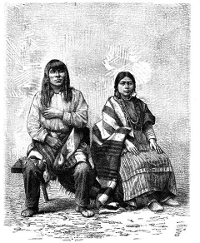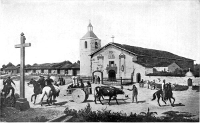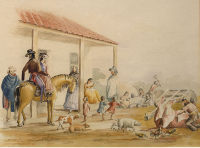The Making of the 50 States: California
Part 1: In the Beginning 
Travelers from Asia are thought to have been in what is now California many, many years ago. Among the Native American tribes known to have lived in the area were the Cahuilleno, Chumash, Karok, Maidu, Mojave, Paiute, Pomo, Maidu, Modoc, Yokuts, and Yuma. They found that corn, potatoes, and other crops that grew in other parts of the country would not grow in the California climate, which was much dryer for much of the year. The Native Americans who lived in California ate salmon and other fish, hunted deer and elk, and ate berries and seeds, in particular acorns, around which a veritable industry of preparation grew. The first European known to have landed in California (and on the West Coast, for that matter) was Juan Rodriguez Cabrillo of Spain on Sept. 28, 1542. He landed in what is now San Diego Bay. They named the land Alta California. Sir Francis Drake arrived in what is now California in 1579. Drake staked a claim for English control of the area, calling it Nova Albion. Sebastian Vizcaino in 1602 was the next Spanish explorer on the scene, reaching San Diego, which he named. He sailed up the coast, discovering many things, and reported glowingly to the monarchy in Spain. The Spanish were initially unimpressed, and no further explorations came for a long while. Russian explorers and traders, based in what is now Alaska and Canada, came to the area in the 1760s. The English were back as well, and the Spanish king decided to retrain his focus on California. 
Starting in 1769, Catholic missionaries from Spain built 21 missions up and down California, from Mission Basilica San Diego de Alcala in what is now San Diego to Mission San Francisco de Solano in what is now Sonoma, a distance of 650 miles. The missions are about 30 miles apart, a distance that was thought to have represented one day's journey for a person on horseback. Father Junipero Serra founded the first of those missions in 1769 at San Diego, also the site of the first permanent European settlement on the Pacific Coast, the Presidio at San Diego. Spanish officials envisioned a highly structured system of governance for Alta California. They had built the missions with the idea of spreading Christianity throughout the new land, and missionaries aimed to convert Native Americans to the Christian faith while also teaching them trades like brickmaking and blacksmithing. At a higher level, Spain divided Alta California into four military districts, with each one having a presidio acting as a controlling interest. Spain built the other three presidios at Monterey, San Francisco, and Santa Barbara. 
Commanding later Spanish expeditions were Gaspar de Portola and Juan Bautista de Anza. Spanish settlers also founded towns, many of them. What is now the largest city in the State of California, Los Angeles, was established in 1781; San Jose, in the north, had come along four years earlier. When Mexico gained its independence from Spain in 1821, California became part of Mexico. The Mexican government took over the missions and took away their purpose; the missions were eventually abandoned, and many were sold into private hands. The rigid control of the Spanish government and the Catholic Church gave way to a more decentralized rule by Mexico. In the wake of the demise of the Spanish influence, a new culture arose: that of the rancher, or ranchero. Next page > The Rest of the Story > Page 1, 2
|
|
Social Studies for Kids
copyright 2002–2024
David White




